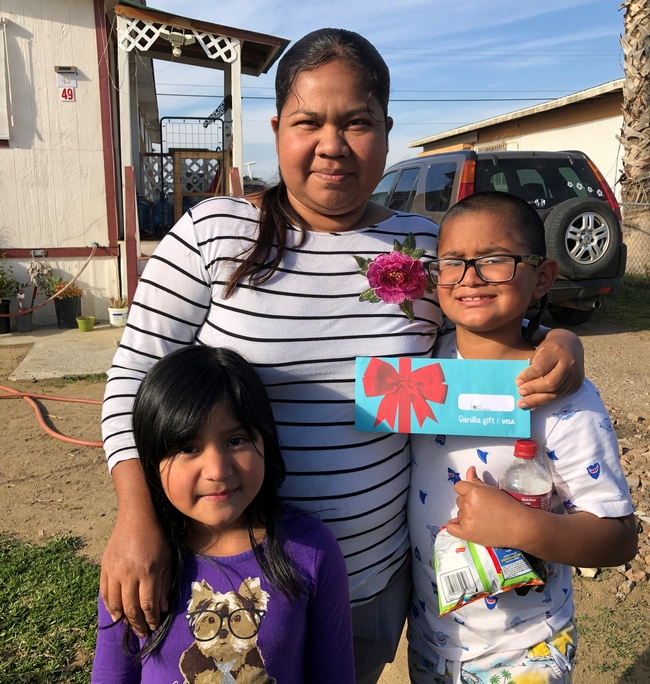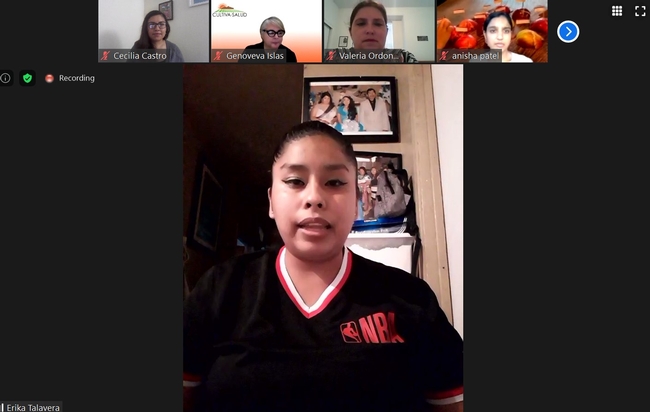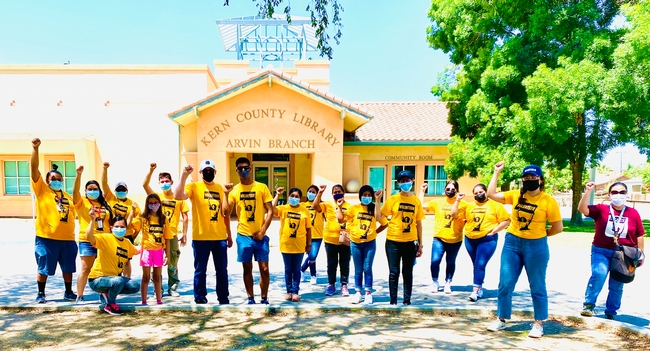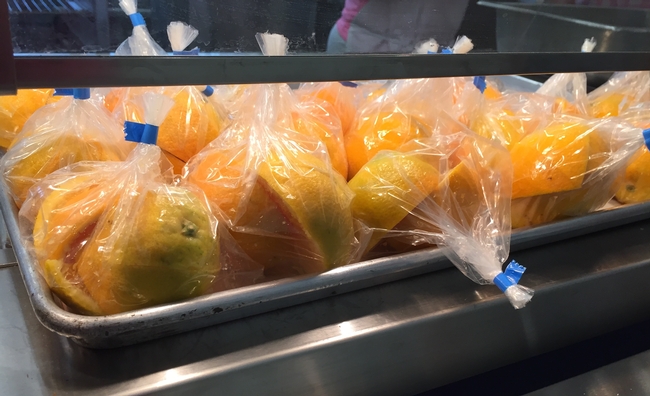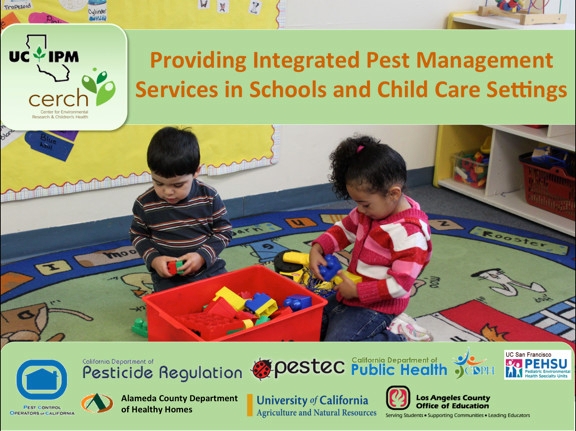Posts Tagged: schools
No break for kids’ hunger: Partnerships help secure school meal programs
Partnering for California
As the gravity of the COVID-19 pandemic hit communities across the U.S. in mid-March 2020, the policy team at UC Agriculture and Natural Resources' Nutrition Policy Institute received an urgent email from a longtime partner in the San Joaquin Valley.
“It was simply entitled 'Help' in the subject line – with multiple exclamation points,” said Christina Hecht, NPI senior policy advisor.
The colleague was writing on behalf of community groups concerned that pandemic-related school closures would jeopardize school meal programs – a nutritional lifeline for children in a predominantly agricultural region with many low-income households.
Hecht immediately contacted a frequent collaborator, Anisha Patel, an associate professor of pediatrics at Stanford University. To help school districts continue those essential meals during the fast-approaching spring holiday, they quickly produced a fact sheet, “Kids' Hunger Doesn't Take a Spring Break,” sharing resources on how districts could use new program flexibility to continue meal distribution.
Then, as the pandemic evolved throughout 2020, the U.S. Department of Agriculture and California Department of Education continued to issue a flurry of waivers and guidance updates. To keep pace, the authors produced three more fact sheets to help districts digest the information and adapt and sustain their school meal programs.
“We tried to make a really user-friendly resource that would help districts sort through everything they needed to do, and easily discover resources for best practices,” Hecht said.
The fact sheet information, paired with advocacy by local partners, encouraged districts to take steps to make more meals more easily accessible to students by taking advantage of USDA waivers: for example, allowing parents to pick up meals without children present, providing multiple meals in one pick-up or implementing bus delivery of meals.
These efforts attracted the attention of the School Nutrition Association, a prominent nonprofit representing more than 50,000 members who provide meals to students across the country. The organization co-branded general versions of the fact sheets and distributed them widely through its website.
Gathering community perspectives on school meals
Those resources represent just one way that lessons from the San Joaquin Valley experience are shaping the national conversation on school nutrition programs. Cultiva La Salud and Dolores Huerta Foundation – health equity and social justice organizations based in Fresno and Bakersfield, respectively – approached the researchers to study ways to boost participation in school meal programs and address food insecurity in their largely Latino communities.
“Working alongside Stanford and NPI is crucial in expanding our capacity and ability to use data and research as a tool to empower parents to advocate for improved health and wellness policies and practices,” said Cecilia Castro, deputy director of Dolores Huerta Foundation, which works in Kern, Fresno and Tulare counties, as well as Antelope Valley in Los Angeles County.
To better understand the “barriers and facilitators” to meal program participation, Hecht, Patel and their collaborators – including student trainees who were eager to learn about community-based participatory research and wanted to help their local communities – sought the perspectives of school district administrators and staff, community groups and parents.
Through the relationships nurtured by Cultiva La Salud and Dolores Huerta Foundation, the researchers convened focus groups of parents with children in six school districts across the San Joaquin Valley.
“We needed to understand better what helped and hindered families from getting the school meals,” Hecht said.
According to Castro, parents have leveraged their feedback to advocate for increased access to school meals, through the use of buses for meal delivery and changes to meal pickup times and locations.
“This engagement has validated the lived experience of our communities,” Castro said. “It has provided an additional strategy for parent leaders to use in efforts to engage decision-makers about ways to improve quality and access to school meals.”
Another key takeaway from these conversations is that the parents are deeply concerned about the content and nutritive value of the meals served to their children.
“We learned that although school meals meet nutrition standards, parents are not aware of this,” Patel said. “Parents also worry about the healthfulness of school meals, noting heavy processing and added sugar. Most compelling was that parents want to provide feedback to improve school meal appeal and healthfulness but have no way to act.”
San Joaquin Valley voices go national
The Nutrition Policy Institute played a crucial role in bringing the parents' perspectives to legislative staff members at the state and federal levels, through the production of four policy briefs that center the voices of San Joaquin Valley residents. In the first, “School Meals: Kids Are Sweeter with Less Sugar,” one parent says: “Children cannot sustain themselves on treats that give pure sugar…They give with the best intentions, but less food would be better, but better quality and healthier.”
“One of the most rewarding parts of all this work has been seeing how meaningful it has been for the parents in the San Joaquin Valley to see their voices getting carried all the way to Washington, D.C. by these policy briefs,” said Hecht. “And it was so meaningful for them that Cultiva La Salud had the briefs translated into Spanish so that the parents could actually read their own words.”
Their voices joined a chorus comprising over 200 organizations who called for universal school meals across California. In June, the state became the first in the nation to adopt a policy, starting in the 2022-2023 school year, to provide free meals for all K through 12 public school students, regardless of family income. Momentum continues to build on the national scale.
The next step for the team is to explore ways to make school meals even more appealing to potential program participants in the Latino communities of San Joaquin Valley. Patel said they will draw on the expertise of Szu-chi Huang, associate professor of marketing in Stanford's Graduate School of Business.
“Using a participatory approach, we will work with parents and school officials to design an intervention focused on communicating the benefits of school meals, and test strategies to improve the appeal of school meals,” Patel explained. “Then we will examine how that intervention affects parents' satisfaction with school meals, students' participation in meals and food insecurity.”
Those insights will be another valuable result of a unique partnership – spurred by a call for help and galvanized by the ongoing health crisis – that continues to benefit families across California.
“Our partnership has been very unusual and very fruitful because we had policy experts, we had research experts and trainees, and then we had the organizations actually working in the community,” Hecht said. “And as we look back on it, it's hard to imagine working that successfully without that kind of partnership.”
Partnerships help secure, improve school meal programs in San Joaquin Valley
Partnering for California
As the gravity of the COVID-19 pandemic hit communities across the U.S. in mid-March 2020, the policy team at UC Agriculture and Natural Resources' Nutrition Policy Institute received an urgent email from a longtime partner in the San Joaquin Valley.
“It was simply entitled ‘help' in the subject line – with multiple exclamation points,” said Christina Hecht, NPI senior policy advisor.
The colleague was writing on behalf of community groups concerned that pandemic-related school closures would jeopardize school meal programs – a nutritional lifeline for children in a predominantly agricultural region with many low-income households.
Hecht immediately contacted a frequent collaborator, Dr. Anisha Patel, an associate professor of pediatrics at Stanford University. To help school districts continue those essential meals during the fast-approaching spring holiday, they quickly produced a fact sheet, “Kids' Hunger Doesn't Take a Spring Break,” sharing tips and resources for the districts.
Then, as the pandemic evolved throughout 2020, the U.S. Department of Agriculture and California Department of Education continued to issue a flurry of waivers and guidance updates. To keep pace, the authors produced three more fact sheets to help districts digest the information and adapt and sustain their school meal programs.
“We tried to make a really user-friendly resource that would help districts sort through everything they needed to do, and easily discover resources for best practices,” Hecht said.
Their efforts attracted the attention of the School Nutrition Association, a prominent nonprofit representing more than 50,000 members who provide meals to students across the country. The organization co-branded general versions of the fact sheets and distributed them widely through its website.
Gathering community perspectives on school meals
Those resources represent just one way that lessons from the San Joaquin Valley experience are shaping the national conversation on school nutrition programs. Cultiva La Salud and Dolores Huerta Foundation – health equity and social justice organizations based in Fresno and Bakersfield, respectively – approached the researchers to study ways to boost participation in school meal programs and address food insecurity in their largely Latino communities.
“Working alongside Stanford and NPI is crucial in expanding our capacity and ability to use data and research as a tool to empower parents to advocate for improved health and wellness policies and practices,” said Cecilia Castro, deputy director of Dolores Huerta Foundation, which works in Kern, Fresno and Tulare counties, as well as Antelope Valley in Los Angeles County.
To better understand the “barriers and facilitators” to meal program participation, Hecht, Patel and their collaborators – including student trainees who were eager to learn about community-based participatory research and wanted to help their local communities – sought the perspectives of school district administrators and staff, community groups and parents.
Through the relationships nurtured by Cultiva La Salud and Dolores Huerta Foundation, the researchers convened focus groups of parents with children in six school districts across the San Joaquin Valley.
“We needed to understand better what helped and hindered families from getting the school meals,” Hecht said.
According to Castro, parents have leveraged their feedback to advocate for increased access to school meals, through the use of buses for meal delivery and changes to meal pickup times and locations.
“This engagement has validated the lived experience of our communities,” Castro said. “It has provided an additional strategy for parent leaders to use in efforts to engage decision-makers about ways to improve quality and access to school meals.”
Another key takeaway from these conversations is that the parents are deeply concerned about the content and nutritive value of the meals served to their children.
“We learned that although school meals meet nutrition standards, parents are not aware of this,” Patel said. “Parents also worry about the healthfulness of school meals, noting heavy processing and added sugar. Most compelling was that parents want to provide feedback to improve school meal appeal and healthfulness but have no way to act.”
San Joaquin Valley voices reverberate
The Nutrition Policy Institute played a crucial role in bringing the parents' perspectives to legislative staffs at the state and federal levels, through the production of four policy briefs that center the voices of San Joaquin Valley residents. In the first, “School Meals: Kids Are Sweeter with Less Sugar,” one parent says: “Children cannot sustain themselves on treats that give pure sugar…They give with the best intentions, but less food would be better, but better quality and healthier.”
“One of the most rewarding parts of all this work has been seeing how meaningful it has been for the parents in the San Joaquin Valley to see their voices getting carried all the way to Washington, D.C. by these policy briefs,” said Hecht. “And it was so meaningful for them that Cultiva La Salud had the briefs translated into Spanish so that the parents could actually read their own words.”
Their voices joined a chorus comprising over 200 organizations who called for universal school meals across California. In June, the state became the first in the nation to adopt a policy, starting in the 2022-2023 school year, to provide free meals for all K through 12 public school students, regardless of family income. Momentum continues to build on the national scale.
The next step for the team is to explore ways to make school meals even more appealing to potential program participants in the Latino communities of San Joaquin Valley. Patel said they will draw on the expertise of Szu-chi Huang, associate professor of marketing in Stanford's Graduate School of Business.
“Using a participatory approach, we will work with parents and school officials to design an intervention focused on communicating the benefits of school meals, and test strategies to improve the appeal of school meals,” Patel explained. “Then we will examine how that intervention affects parents' satisfaction with school meals, students' participation in meals and food insecurity.”
Those insights will be another valuable result of a unique partnership – spurred by a call for help and galvanized by the ongoing health crisis – that continues to benefit families across California.
“Our partnership has been very unusual and very fruitful because we had policy experts, we had research experts and trainees, and then we had the organizations actually working in the community,” Hecht said. “And as we look back on it, it's hard to imagine working that successfully without that kind of partnership.”
NPI applauds Smart Snacks for schoolchildren
With an eye on reducing childhood obesity and improving overall health for children, the U.S. Department of Agriculture announced the final rule for snacks at schools. The rule made final on July 21 includes requiring snacks served at school to meet nutritional standards similar to those required of school meals.
Lorrene Ritchie, director of UC ANR's Nutrition Policy Institute applauds the USDA for their recently final Smart Snacks in School rule, which complements the nutritional improvements made to school lunches and breakfasts through the Healthy, Hunger-Free Kids Act.
Creating school environments that offer more healthful foods such as fresh fruits, vegetables and whole grains can also influence the way children eat at home and away from school.
“No single setting has the potential to influence the nutrition of more children than schools,” said Ritchie.
“Research – conducted by our Nutrition Policy Institute and others – has demonstrated that the healthy school foods and beverages consumed by children have a positive impact on their overall diet quality,” she said.
USDA also now requires any food or beverage that is marketed on school campuses during the school day to meet the Smart Snacks standards. Children are a target market for many foods and beverages that contain low nutritional quality and high calories that contribute to excess weight. To be advertised on a school campus, foods and beverages must meet the same Smart Snack standards for items sold or served by a school, according to the new Local School Wellness Policy rule.
“We are starting to see a leveling of child obesity rates in some places and changes to the school food environment are essential to furthering this progress,” said Ritchie.
Providing a consistent source of nutritious food at school will help the approximately 6.2 million California K-12 students develop healthy eating habits for life.
To read more about the federal changes to school food requirements, read the USDA news release at http://www.usda.gov/wps/portal/usda/usdahome?contentid=2016/07/0172.xml&contentidonly=true.
Online course helps control pests, protect children
Free UC IPM course helps pest management professionals understand the Healthy Schools Act and provide IPM services to schools and child care centers
Pest management professionals can learn about the requirements of California's Healthy Schools Act by taking a free online course provided by the UC Statewide Integrated Pest Management Program (UC IPM), part of University of California Agriculture and Natural Resources (UC ANR).
To minimize children's exposure to pesticides, California requires pest control operators providing services in schools and licensed child care centers to comply with a series of laws called the Healthy Schools Act. The laws promote integrated pest management (IPM) in public K–12 schools and licensed private child care centers.
The free course Providing Integrated Pest Management Services in Schools and Child Care Settings explains what the Healthy Schools Act requires of schools, child care centers and pest control companies when managing pests in these environments.
"Taking the online course makes it easier to understand and comply with the laws," said Andrew Sutherland, UC ANR Cooperative Extension IPM advisor. "Pest management professionals can take the course at their convenience. It tells them everything they need to know about the Healthy Schools Act and IPM in order to do business with a school or child care center."
The course also includes a section on how companies can prosper by incorporating IPM principles and practices into their businesses.
"This is an opportunity for operators to take their businesses to the next level by adopting IPM practices," Sutherland said. "IPM effectively and efficiently manages pests, builds professionalism within providers, and captures value for the customer while minimizing pesticide applications, pesticide exposures and associated negative impacts on children's health, the environment and the larger community."
Licensed pest-management professionals can receive continuing education units by completing the online course: one "Rules and Regulations" and one "IPM" from the Structural Pest Control Board; and one "Laws and Regulations" and one "Other" from the Department of Pesticide Regulation.
UC Berkeley's Center for Environmental Research and Children's Health is developing a database of individuals who complete the course so that schools and child care centers can connect with pest control providers who are familiar with IPM and the Healthy Schools Act.
The training module was developed by Sutherland and collaborators at UC Berkeley and UC San Francisco, with input from California pest management professionals and child care providers.
To take the free Providing Integrated Pest Management Services in Schools and Child Care Settings course, see the UC IPM website http://ucanr.edu/ipm4schools.
This project was funded by the California Department of Pesticide Regulation Pest Management Alliance Program. For more information about the Healthy Schools Act, visit the California Department of Pesticide Regulation's School IPM web page http://apps.cdpr.ca.gov/schoolipm.
An initiative to maintain and enhance healthy families and communities is part of the UC Agriculture and Natural Resources Strategic Vision 2025.

